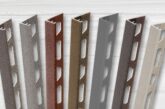
Andrew Curry, Training Manager at Schlüter Systems, answers your questions on Kerdi Board
Q. What is Kerdi–Board made of and how does it maintain its waterproof credentials?
A. Schlüter-Kerdi-Board is a multi-functional tile backerboard. The core of the board is made of an extruded polystyrene (XPS), with a waterproof cement-free reinforcement layer on both sides.
Q. Which substrates is Kerdi–Board suitable for?
A. The product is designed to replace sheet materials that should be avoided in wet areas, such as plywood or plasterboard. It can be installed directly onto traditional stud frames made of wood or metal. The material can also be installed directly onto masonry using dabs of adhesive (like plasterboard).
 Q. Is there a range of thicknesses available? What do I need to bear in mind when specifying a particular thickness?
Q. Is there a range of thicknesses available? What do I need to bear in mind when specifying a particular thickness?
A. Yes, Kerdi–Board is available in thicknesses of 5, 9, 12.5, 19, 28, 38 and 50mm. The type of application will dictate the thickness required. For installing onto stud frames, the wider the stud frame then the thicker the board. Where the stud frame is constructed to 400mm centres, a 12.5mm thick board is the minimum recommended thickness. If used for construction purposes, then generally the 28, 38 or 50mm sizes can be considered, depending on the design, of course. A ‘Board selection and fixing guide’ is available to help with choosing board thickness.
Q. Can I use it in curved constructions or for pipe boxing?
A. Absolutely! Schlüter offers L- or U- shaped versions for pipe boxing, as well as a board with vertical grooves for creating curved features such as walls or seating. These prefabricated options make installation quicker and easier.
Q. What other uses is the material suitable for?
A. Kerdi-Board is often referred to as ‘LEGO for installers’… its limits are your own imagination! It can be used to create kitchen countertops, vanity units, shelving, and partition walls. Don’t be fooled by how lightweight it is; because it can hold significant loads. Over the years, we have seen all sorts of concepts come to fruition, including a pet feeding station, dog shower and even an impressive Millennium Falcon!
Q. Can it be used in flooring?
A. Yes, providing the flooring system is load bearing it can be used in residential floor areas. Typically, this would be for insulation benefits or waterproofing.
Q. Can you give us an indication of the full range?
A. Sure, all seven thicknesses are available in a choice of 2.6m or 1.25m long boards, both lengths are 62.5cm wide. As well as the prefabricated boards for pipe boxing and curved designs, Kerdi–Board niches are available in various sizes, with or without lighting to create storage in wall areas.
Q. Do you need any special tools? To cut the boards to size, for instance?
A. No special tools are required to work. The thinner boards can be easily cut using a utility knife, with the imprinted gridlines making this easier. We’d recommend cutting the thicker boards using hand tools or power tools to give a neat, square edge. Being cement-free, no dust is created when cutting for a healthier, cleaner working environment.
![]()
Q. What adhesive will I need to use and does the system also require wall anchors? Is the adhesive applied to the substrate or the board? What screws would be suitable for the system?
A. A cement-based tile adhesive is used and can be applied to either the substrate or the Kerdi–Board. Depending on the substrate, you’ll need to either fully embed the board or use the dot and dab method. For intricate details or when using the thinner boards, we’d recommend Schlüter-Kerdi-Fix, a MS polymer-based elastic adhesive. If needed, there’s also a range of hardware accessories for mechanical fixing, including screws, washers, wall anchors and a selection of brackets.
Q. How are any joints sealed?
A. To ensure a fully waterproof installation, the joints and corners must be fully covered with the sealing band Schlüter–Kerdi-Keba, which is embedded using the sealing adhesive Schlüter-Kerdi-Coll-L. The Schlüter range includes pipe collars and prefabricated corners for waterproofing these potentially tricky areas.
![]()
Q. What are the typical curing times?
A. If using Kerdi–Coll-L, you’ll need to allow an hour for this to fully cure before tiling, as well as observing the curing time of the chosen tile adhesive if this has been used too.
Q. What support do you offer tradespeople who are installing Kerdi Board? Is there any training available?
A. Being different to many other boards on the market, Kerdi–Board usually generates a lot of interest with installers so is a key part of our training courses. We have installation documents to help if needed, although we often receive feedback that it’s an incredibly easy product to work with.
For further information on Schluter Kerdi-Board visit: Substrates & building (schluter.com).







